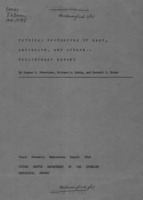This summary is the result of a search of the available literature. Emphasis is placed on the mechanical and calorimetric properties of salt; the measurements of elastic, thermal, magnetic, and mass properties of salt are merely tabulated.
Under hydrostatic pressure < 1,000 kg/cm2 at room temperature, salt deforms plastically to strains > 100 percent at a nearly constant stress difference of about 300 kg/cm2. Similarily, under temperatures > 400?C at one atmosphere, salt deforms plastically to strains > 100 percent under stress differences of about 100 kg/cm2.
Entha1pies were calculated for various temperatures to 2,000? C from the low temperature and high temperature heat capacities and the heats of solution of the following minerals: salt (or halite), NaCl; anhydrite, CaS04; quartz, Si02; and calcite, CaC03. Three combinations of these minerals were assumed to represent three possible natural salt beds, and the heats required to raise the temperature of each to 1,500?C and to 2,000?C were calculated. For a half and half mixture of salt and anhydrite, 1,300 cal/gm were required to raise the temperature to 2,000?C. For an evaporite containing 60 percent salt and
about equal amounts of anhydrite, calcite, and quartz, 1,100 cal/gm are required to raise the temperature to 2,OOO?C.
Most of the measurements of the elastic moduli were made on single crystals of salt, anhydrite, and gypsum. For the most part, the measurements of density, magnetic susceptibility, and other properties were made on natural salt samples.


